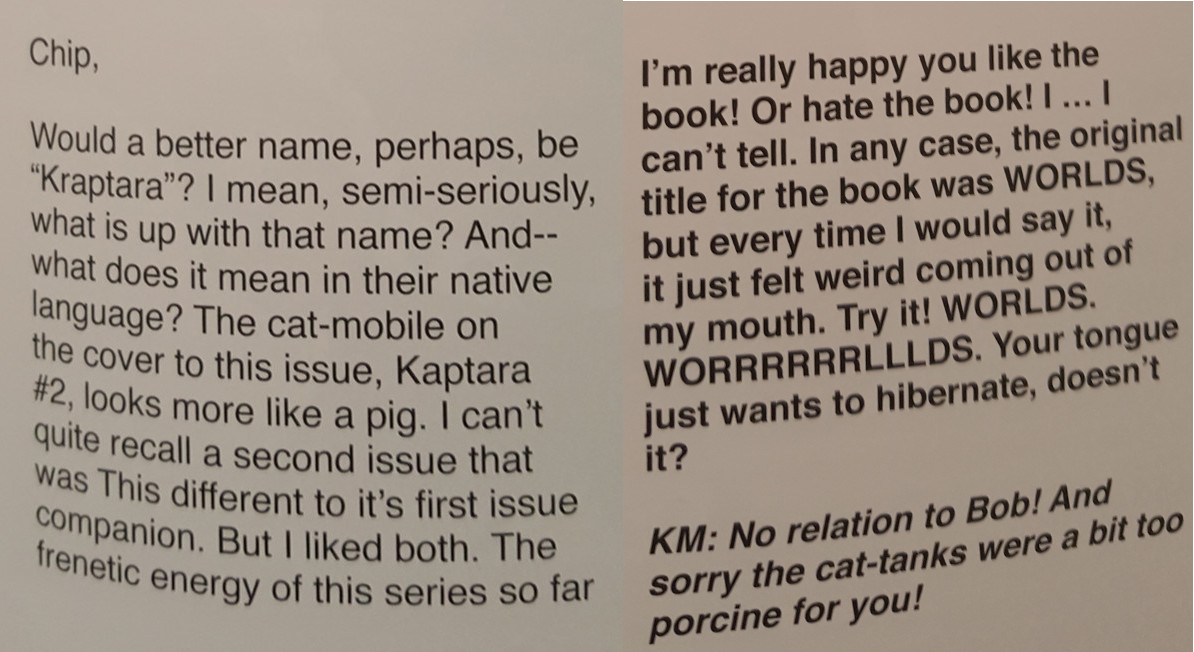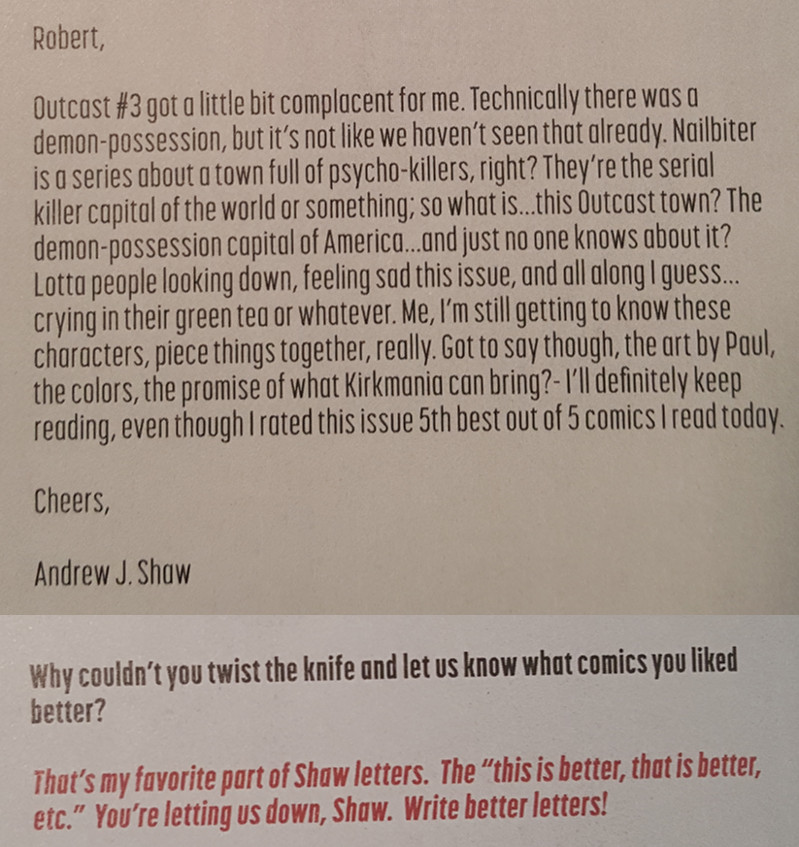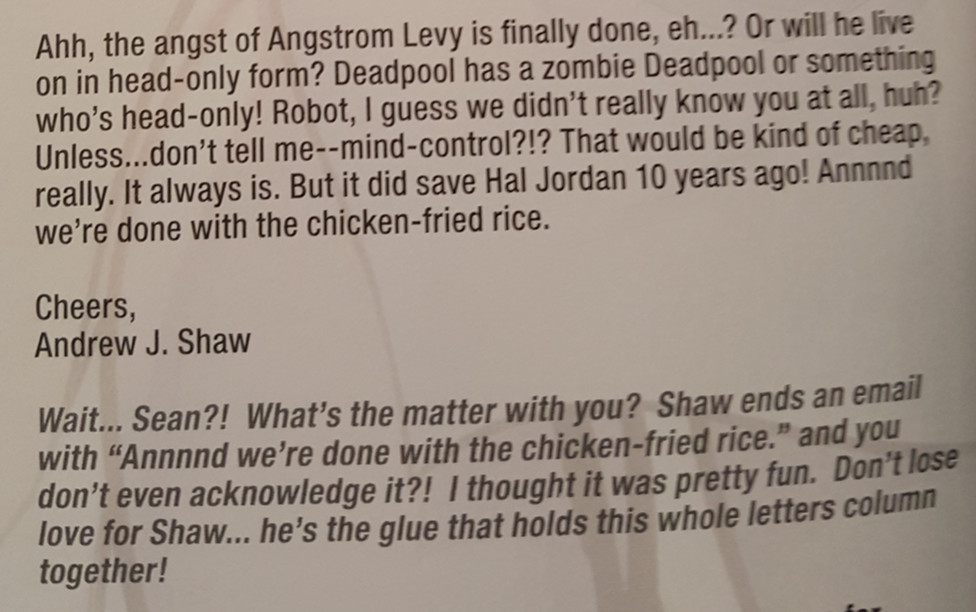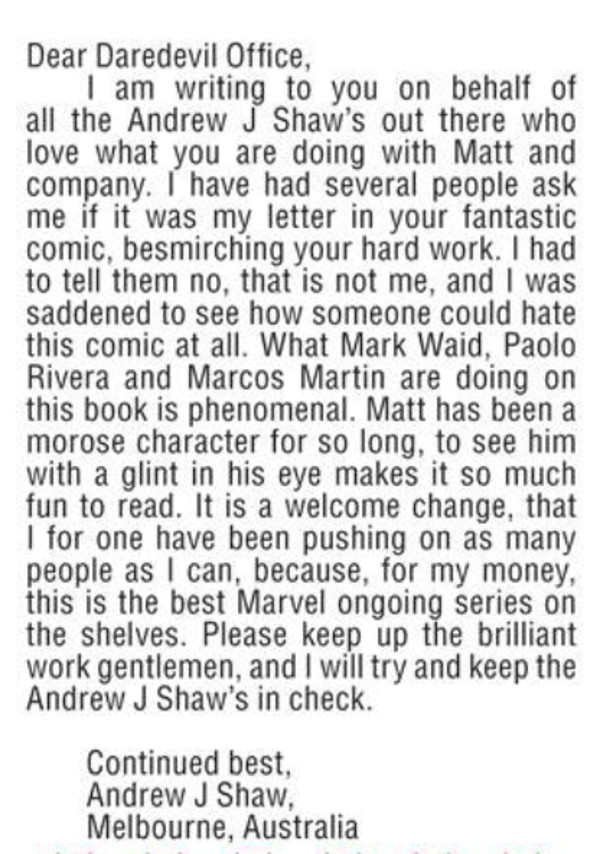Postcards from the Edge: Taking a Deeper Look at Image Comics’ Greatest Villain
We reveal the identity of Image's secret villain
While heroes get most of the publicity, their counterpoints – villains – can become every bit as popular and important to readers as the protagonists they vex. It’s because of the power and influence they have on the stories and comic universes they inhabit. When you think of the great villains of comic lore – I’m talking the Thanos, Magneto and Lex Luthor types – they don’t just impact one comic. They affect everyone in the world around them. It’s part of what makes event comics so spellbinding. How could the heroes ever overcome something so great?
At Image Comics, that character type doesn’t exist, or at least not in the same way. Creator-owned comics are mostly separate endeavors. A villain in Saga won’t appear as a scourge in Southern Bastards. Zombies from The Walking Dead won’t show up in Shutter (or at least not in the same capacity). It’s something that makes these books both great and more accessible, but also something that some fans – the ones raised on superhero comics – may miss occasionally.
But for those that pay close attention, Image does have a unifying villain. While this person isn’t in the same vein as an Annihilus or a Red Skull, they band readers together deep in the background of almost every Image title. They are a unifying force that strengthens the fortitude of readers, writers and artists, reminding us we’re all in this together.
No, this person isn’t a traditional villain. But in his own way, he haunts the dreams of the creators behind Image titles and drives readers mad with rage. That person?
His name is Andrew J. Shaw.
Letter Hacked
Do you know what a letter hack is? It’s the nomenclature the comic industry uses for those who write letters into comics. Letters have existed in some capacity for almost as long as comics have, and these letter hacks have become staples in the books they write into.
Andrew J. Shaw is no different than those that preceded him, except for his often antagonistic positioning. While he often writes positive letters, even those feel negative at times, as we’ll get to. I first became aware of his work in the appropriately titled letters column in Robert Kirkman and Charlie Adlard’s The Walking Dead: Letter Hacks. Shaw’s presence was near constant, as were the strange and adversarial positions he’d take on the comics he wrote into. Sina Grace, the cartoonist of the upcoming graphic novel Self-Obsessed, previously edited the comic and ran the letters column. He remembers Shaw well, as the prominent letter hack didn’t just write in on occasion. He wrote in for every issue.
“I may be wrong here, but I am fairly certain that homeboy wrote a letter for every issue of the main Skybound books,” Grace said, referring to TWD, Invincible, Super Dinosaur and more. “Maybe I’m wrong, but I think I’m right.”
If his only memorable attribute was the frequency of his appearances, he wouldn’t stand out. Many letter hacks make return visits to previous haunts. That’s a standard feature. What makes Shaw unique, however, are the tropes common to his letters. It’s as if Shaw – like Thanos or Magneto – has his own continuity, and he is perpetually building on it in ways noticeable to others who read and write into letters columns. Shaw’s more than a person; he’s an Image Comics character in his own right.
Classic Shaw tropes include:

1. The “Does He Love It or Hate It?” letter
As you can see in the example above from Kaptara #4 by Chip Zdarsky and Kagan McLeod, Shaw has the rare ability to write letters that confound those receiving them. Does Shaw like the book or doesn’t he? Seemingly he does, but it’s always delivered in what can often be described as backhanded compliments. Except he intends them to be insulting before he makes it back to complimentary. I think. Actually, I don’t know. He might not mean to be insulting? It’s really hard to tell sometimes.
2. The “Compliment by Way of Tearing Down Another Book” letter
This is classic Shaw. He loves talking about other Image books he dislikes on the way to complimenting the book he’s writing into, as you can see in this letter from The Autumnlands #5 by Kurt Busiek and Benjamin Dewey. Why just compliment that book when he can also insult another title at the same time? My best guess for the reasoning behind this one: he never wants those receiving the letters to know what to expect. Always keep them guessing.

3. The “This is Better, That is Better, etc.” letter
I’m stealing that title from Robert Kirkman himself, as Kirkman used it to describe the letter Shaw sent in for Outcast #5. It’s a common move from Shaw – where he talks about all of the comics he preferred to the one he’s writing about – and one he mostly uses in vague terms to frustrate those receiving the letters. Skybound editor Sean Mackiewicz was feeling the burn from that one, as you can see, but Kirkman rolls with it. Kirkman’s wise to his game.

4. The Random Outro
To me, this feels like another tactic Shaw uses to keep everyone guessing. As you can see in Shaw’s letter from Invincible #110, Shaw closes with an announcement that he finished his chicken-fried rice. Was he cooking chicken-fried rice while writing the letter? Was he eating it? I don’t know! No one knows! It’s hard to feel too insulted when you’re too busy figuring out what direction Shaw’s coming from and where he’s going. All I know is I’m hungry.
What Kirkman said at the end of that last letter, though, is important. It’s easy to read it like Kirkman is joking when he said, “Don’t lose love for Shaw…he’s the glue that holds this whole letters column together!” But I don’t think so. Shaw’s the glue guy for many a letters column, as he gives other readers someone to push back against. His tropes and presence are so well known that other letter hacks reference him when they send in their own letters (see: these examples from Invincible #107 and Outcast #9). Grace even shared that convention goers have come up to him to ask if Shaw is real.

Other unfortunately named readers feel splash back from his actions. In researching this piece, I came across another comic reader named Andrew J. Shaw who I thought might be the Andrew J. Shaw. When I reached out, this Shaw shared that he wasn’t the one I was searching for. I also wasn’t the first person to ask him this question. That Shaw was impossible to find. However, the Shaw I reached out to shared a fun fact. In his life, he had only written one letter into a comic – an issue of the recent Daredevil title from Mark Waid and Paolo Rivera – and it was to stand up for his own name against the villainous Shaw.
“I’ve only ever had one letter published, in an early Waid Daredevil,” he said. “(It was) actually in response to the other Andrew, saying not all of us hate comics.”
His fame isn’t exclusive to readers, though. He’s known within the creator community as well. Joe Keatinge, the writer of Shutter and the upcoming Ringside, loved receiving a letter from Shaw for Shutter #4. Keatinge noticed Shaw’s work over the years in other Image titles, and he became a fan.
“(laughs) I love his work. For real,” Keatinge said. “Seeing his persistence over so many Image titles in the years since has been impressive.”
While Keatinge was happy to receive a letter from the villain of Image lore, he was unimpressed by what he brought to the table in his letters. He wanted more from the vaunted antagonist.
“It meant a lot to get a letter from him, but I gotta admit he’s been boring as hell recently. I’ve been writing him critiques back so he can up his game again,” Keatinge said. “It’s been really disappointing.”
Grace once spotted Shaw in another letters column, and that moment inspired him to reach out to the person who edited that book.
“The other big memory I have about Andrew is seeing one of his letters show up in a Hellboy-related title,” Grace said. “I may have e-mailed Scott Allie about that and been like, ‘You too!?’”
Jay Faerber of Copperhead fame has long received letters from Shaw. In fact, if you Google “Andrew J. Shaw,” a review of Noble Causes #35 comes up on the first page. That review is mostly about a letter Shaw wrote to the book. It says, “There’s also something in the letter column that I think everyone should read. It is a letter by someone calling himself Andrew J. Shaw. It is without a doubt the biggest asshole letter I have ever read in a comic book.” Spectacular.
Faerber – who “used to get (letters) all the time” from Shaw before he stopped publishing them – isn’t buying Shaw’s game though.
“Oh yeah, he’s definitely got a schtick,” Faerber said. “He seems to be trying to ape Zach Galifianakis’s ‘Between Two Ferns’ bit, where he’ll wrap insults up in otherwise innocuous statements or questions.”
That realization was part of the impetus of Faerber no longer publishing his letters. Plenty of others do, though. In flipping through copies of Image titles over the past year, I discovered letters from Shaw in Kaptara, Outcast, The Walking Dead, Invincible, Shutter, The Autumnlands, Birthright and Lazarus. Sebastian Girner, who edits seven Image titles including Southern Bastards and Deadly Class, said he’s received several letters from Shaw on varying titles. Some of them were even positive!
Say what you will about the guy, but he gets around.
The Man. The Myth. The Legend.
One has to wonder the motivation behind this vaunted letter hack. Is it all an act like Faerber thinks? Is it a game he is playing? Is he just a guy with polarizing opinions who likes writing letters? The thought of Shaw being a construct created by Robert Kirkman even came into my mind. He’s that inexplicable.
While I never found Shaw, in the process of researching this piece, I began to understand the man underneath the letters column persona. Shaw’s just a guy, and in his own way, he’s become essential to the fabric of Image Comics letters columns. Like Kirkman said (maybe facetiously), he’s the glue that ties the whole thing together. His extreme takes have motivated other letter hacks to write in letters and make their presence felt, if only to be a ray of light in the bizarre darkness Shaw brings to the page. Like in comics, he’s the villain that helps bond the heroes – the letter hacks – together through his misdeeds. He’s the heel that helps unify the audience in ways the comic itself may not even be able to.
Even beyond that, just look at the list of titles I found letters from him in. That’s at least ten Image titles he’s reading, without even mentioning Daredevil, the latest issue of Runaways and assorted Mignolaverse titles. He may be a villain, but in his own way, he’s doing Image creators a service even beyond his Thanos-like presence to their letters columns: he’s buying the books.
“He may be the scourge of creator-owned letters columns everywhere, but if he’s really throwing down for all these books every week he’s putting all our kids through college,” said Girner.
“Amazingly enough, our ‘banter’ in the letters columns inspired him to pick up The Li’l Depressed Boy (which I draw), and him sending us pretty hilarious letters every issue there, too!” said Grace. “Thanks for the support, AJS!”
So yeah, sure, he confounds readers and creators. He may also have the tendencies of an antagonist. But in his own way, Andrew J. Shaw isn’t just Image’s greatest villain. He may be their greatest hero as well.
Thanks to Jay Faerber, Sebastian Girner, Sina Grace, Joe Keatinge and the other Andrew J. Shaw for the commentary. Shout out to AJS. You know I love you. Email me if you read this! Also, I fully admit there’s the possibility that he reads comics for free at the comic shop he works at, but I don’t believe it. No sir.
Header image taken from images on Image Comics’ site and from KBStories site.
